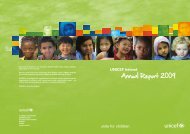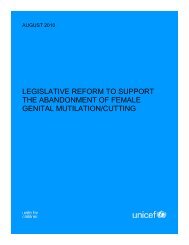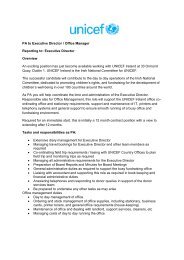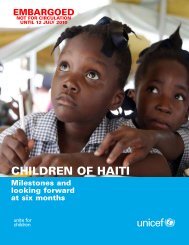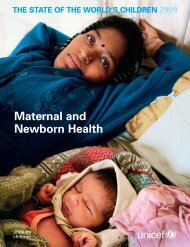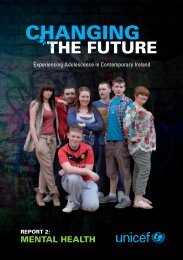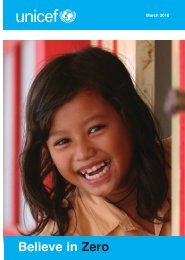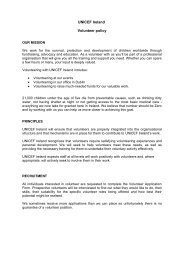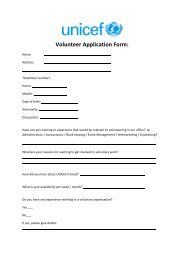Humanitarian Action for Children 2011 - Unicef
Humanitarian Action for Children 2011 - Unicef
Humanitarian Action for Children 2011 - Unicef
- No tags were found...
You also want an ePaper? Increase the reach of your titles
YUMPU automatically turns print PDFs into web optimized ePapers that Google loves.
SUDAN© UNICEF/NYHQ2006-0559/Noorani<strong>Children</strong> and women line up to collect water, in theAbu Shouk camp, near El Fasher, capital of NorthDarfur State. Some 4.3 million Sudanese remaindisplaced by years of conflict.Page 51.YEMEN© UNICEF/NYHQ2009-1734/BrekkeA woman bathes her son outside their tent inthe Al-Mazrak camp in Hajja. Acute emergenciesand chronic underdevelopment, characterized byshortages of food, water, sanitation and health care,have displaced hundreds of thousands of people.Page 52.LATIN AMERICA AND THE CARIBBEAN© UNICEF/NYHQ2010-2639/LeMoyneA girl stands in her Port-au-Prince home, whichwas heavily damaged by the 12 January 2010earthquake in Haiti. Natural disasters characterizemajor emergencies in the region, which also hasgreat disparities between rich and poor.Page 53.COLOMBIA© UNICEF/NYHQ2009-1773/MarkiszCarlitos, 8, stands in front of his home, which sits ona toxic landfill in a poor Medellín neighbourhood.Decades of armed conflict, drug-related violenceand recent intense flooding have displaced millionsand deepened social inequalities.Page 56.GUATEMALA© UNICEF/NYHQ2007-2754/VersianiA girl walks on a dirt road in Salquil Grande Village, ElQuiché Department. In 2010, irregular rains and unusuallyhigh temperatures cut food production, leadingto high levels of undernutrition among children.Page 57.HAITI© UNICEF/NYHQ2010-2128/DorminoSisters are treated <strong>for</strong> cholera in Artibonite Department.The cholera epidemic that began in October2010 struck a blow to ef<strong>for</strong>ts to recover from the 12January earthquake that killed more than 222,000people and displaced more than 2 million.Page 58.WEST AND CENTRAL AFRICA© UNICEF/NYHQ2010-1160/GangaleWomen bring their children <strong>for</strong> nutrition screeningsin Nokou, Chad. Cyclical drought, severe pressureon limited natural resources and outdated farmingpractices have crippled food production in theSahel region.Page 59.BURKINA FASO© UNICEF Burkina Faso/2009/TarpilgaA girl who was displaced by floods in 2009 eatsready-to-eat therapeutic food in Ouagadougou,Burkina Faso’s capital. Entrenched poverty, floodingand epidemics continue to challenge the country,despite a recent decline in global acute malnutritionrates.Page 62.CAMEROON© UNICEF/NYHQ2010-2322/BouvetMartine Daoundala sits outside her home with herdaughter in the village of Ziver. <strong>Children</strong> and womenin the eastern and northern regions of Cameroonstruggle to share limited access to health and otherservices with a fluctuating refugee population.Page 63.CENTRAL AFRICAN REPUBLIC© UNICEF Central African Republic/2009/de Hommel<strong>Children</strong> stand in the town of Boura. Deep poverty,resurgent conflict and the flow of refugees fromneighbouring countries, have left the country’schildren vulnerable to disease and exploitation.Page 64.CHAD© UNICEF/NYHQ2010-1152/AsselinA boy sits in a transit and orientation centre <strong>for</strong>children <strong>for</strong>merly associated with armed <strong>for</strong>ces orgroups in N’Djamena. Such recruitment remains acritical problem in eastern Chad.Page 65.CONGO© UNICEF/NYHQ2010-2803/AsselinA girl carries a boy in Djambala, where UNICEFparticipated in polio vaccination campaigns in late2010 during the country’s deadly polio outbreak.The epidemic was centred around the port city ofPointe-Noire.Page 66.Côte d’Ivoire© UNICEF/NYHQ2010-2469/KamberA girl carries a bowl in a market in Adjamé, a poorneighbourhood in the city of Abidjan. Ongoing conflict,including violently disputed national elections,have exposed children and women to exploitativelabour and sexual violence.Page 67.DEMOCRATIC REPUBLIC OF THE CONGO© UNICEF/NYHQ2008-1328/AsselinAdolescent survivors of sexual violence wait tobe seen at a hospital in Goma. By late 2010, anestimated 1.7 million Congolese were still displacedby conflict, and sexual violence was continuing atcatastrophic rates.Page 68.NIGER© UNICEF/NYHQ2010-1593/HoltzA girl drinks a mixture of millet, milk and sugar ina village in Maradi Department. Inadequate rainfall,outdated farming methods and demographic pressureare causing food insecurity that threatens halfthe country’s population.Page 69.72 <strong>2011</strong> UNICEF <strong>Humanitarian</strong> <strong>Action</strong> FOR CHILDREN | www.unicef.org/hac<strong>2011</strong>




